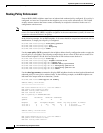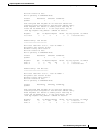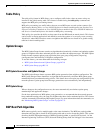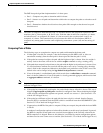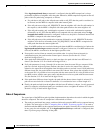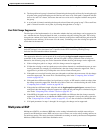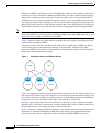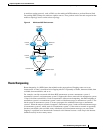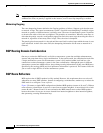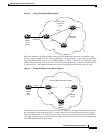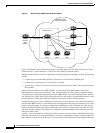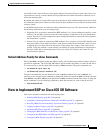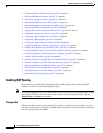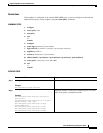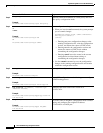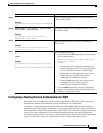
Implementing BGP on Cisco IOS XR Software
Information About Implementing BGP on Cisco IOS XR Software
RC-24
Cisco IOS XR Routing Configuration Guide
Note No penalty is applied to a BGP peer reset when route dampening is enabled. Although the reset
withdraws the route, no penalty is applied in this instance, even if route flap dampening is enabled.
Minimizing Flapping
The route dampening feature minimizes the flapping problem as follows. Suppose again that the route
to network A flaps. The router in autonomous system 2 (in which route dampening is enabled) assigns
network A a penalty of 1000 and moves it to history state. The router in autonomous system 2 continues
to advertise the status of the route to neighbors. The penalties are cumulative. When the route flaps so
often that the penalty exceeds a configurable suppression limit, the router stops advertising the route to
network A, regardless of how many times it flaps. Thus, the route is dampened.
The penalty placed on network A is decayed until the reuse limit is reached, upon which the route is once
again advertised. At half of the reuse limit, the dampening information for the route to network A is
removed.
BGP Routing Domain Confederation
One way to reduce the iBGP mesh is to divide an autonomous system into multiple subautonomous
systems and group them into a single confederation. To the outside world, the confederation looks like
a single autonomous system. Each autonomous system is fully meshed within itself and has a few
connections to other autonomous systems in the same confederation. Although the peers in different
autonomous systems have eBGP sessions, they exchange routing information as if they were iBGP peers.
Specifically, the next hop, MED, and local preference information is preserved. This feature allows the
you to retain a single IGP for all of the autonomous systems.
BGP Route Reflectors
BGP requires that all iBGP speakers be fully meshed. However, this requirement does not scale well
when there are many iBGP speakers. Instead of configuring a confederation, another way to reduce the
iBGP mesh is to configure a route reflector.
Figure 3 illustrates a simple iBGP configuration with three iBGP speakers (routers A, B, and C). Without
route reflectors, when Router A receives a route from an external neighbor, it must advertise it to both
routers B and C. Routers B and C do not readvertise the iBGP learned route to other iBGP speakers
because the routers do not pass on routes learned from internal neighbors to other internal neighbors,
thus preventing a routing information loop.



